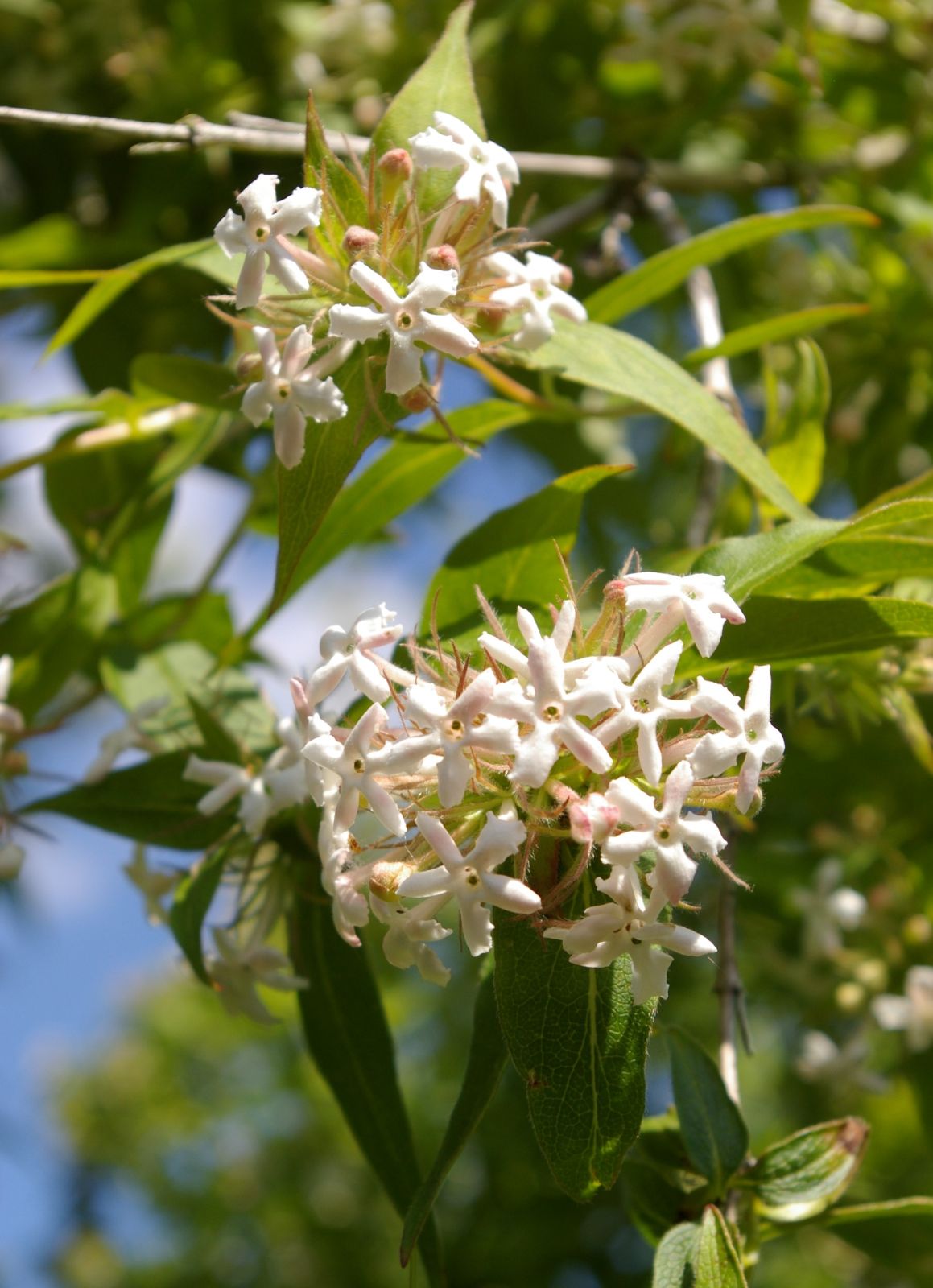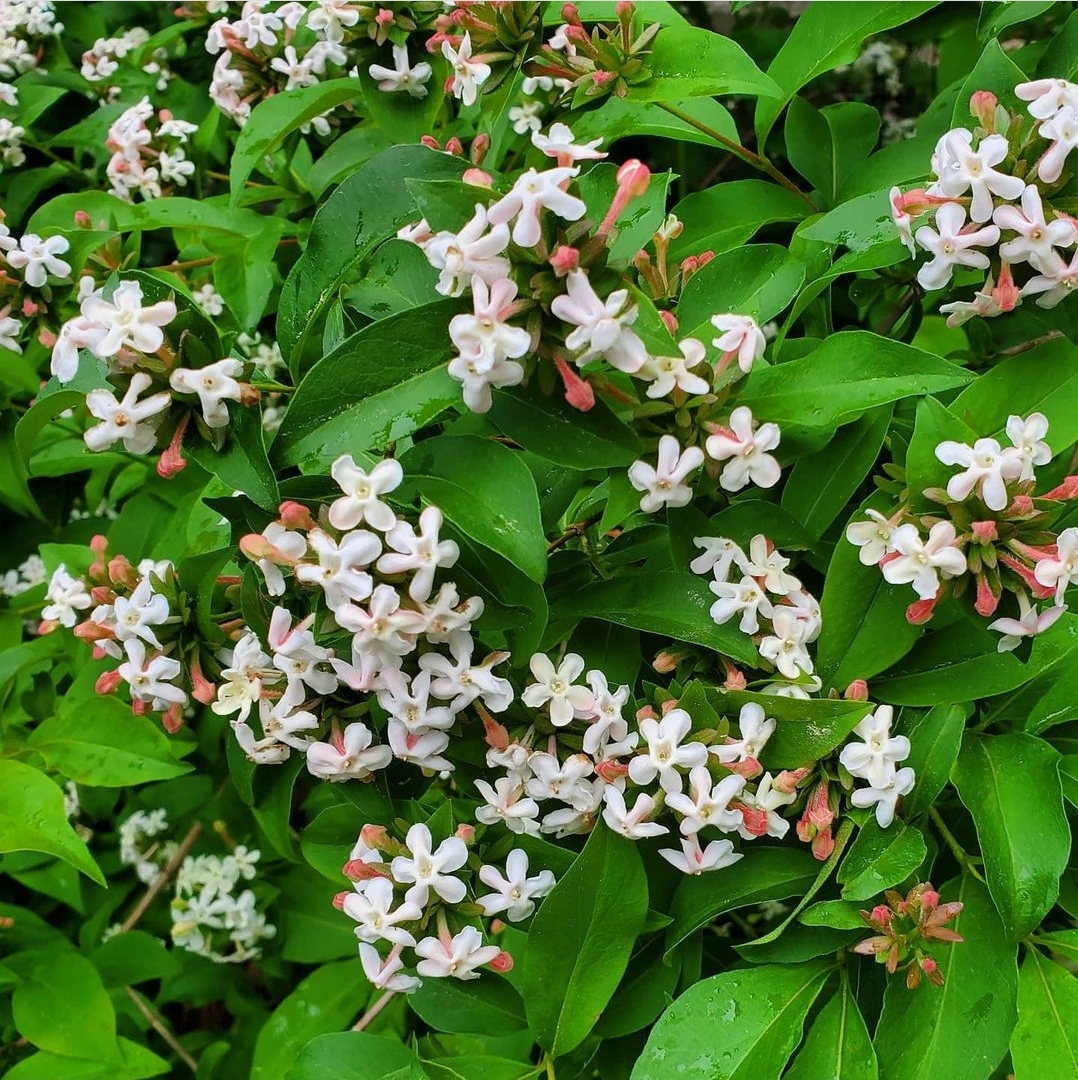Zabelia
Credits
Owen Johnson (2021)
Recommended citation
Johnson, O. (2021), 'Zabelia' from the website Trees and Shrubs Online (treesandshrubsonline.
Family
- Caprifoliaceae
Common Names
- Mountain Abelia
A group of about 8 deciduous shrubs, one species sometimes a small tree. Shoots thickened at the nodes, often with stiff, bent hairs; twigs usually with 6 longitudinal grooves; old bark sometimes stringy. Buds in opposite pairs, hidden through summer within the 2 swollen bases of the leaf-stalks, which are connate. Leaves simple, thin in texture, matt or glossy, 1–8 cm long, ovate to lanceolate, entire or distantly toothed or variously lobed on strong growths. Flowers in spring to summer, in axillary pairs or clustered in a congested terminal thyrse of sessile cymes. Calyx of 4 or 5 sepals. Corolla 1–2 cm long, salver-shaped, with a long tube and a flat disk of 4 or 5 lobes, white, or pink to reddish outside, glandular within. Stamens 4, shorter than the corolla-tube; anthers yellow. Ovary usually 3-locular, 2 locules with 2 series of sterile ovules and 1 locule with a single fertile ovule. Stigmas green, mucilaginous. Fruit ripening in autumn, a leathery achene, crowned with the persistent calyx lobes and wind-dispersed. (Flora of China 2021).
Zabelia are quite similar in floral morphology to plants in the tribe Linnaeeae and were traditionally placed, within that tribe, as members of a large and diverse genus, Abelia. Visual differences include longitudinally grooved twigs, winter-buds hidden through summer in the swollen and connate bases of the paired leaves, and flowers which are shaped like bar-stools (or like those of the related genus Viburnum), with a long narrow tube abruptly flaring into a flat disk of four or five corolla-lobes. These flowers are often described in the wild as white but in many garden specimens are bi-coloured, with corollas white inside and rosy red outside, from crimson buds; this may suggest a degree of selection in cultivation. As in some species from two other related genera, Lonicera and Symphoricarpos, the otherwise rather oval leaves can be variously and strikingly lobed on strong growths.
The name Zabelia was published by Alfred Rehder in 1911, originally as a section within Abelia, and commemorates the German dendrologist Hermann Zabel (1832–1912); it would be easy to imagine that Rehder picked Zabel’s name because of its mnemonically convenient similarity to that of Clarke Abel, after whom Abelia itself is named, but Zabel was in fact the first botanist to split Abelia into sections, in 1893 (Flora of China 2021). Zabelia was elevated to generic rank by the Japanese botanist Tomitaro Makino in 1948, but it was only around the start of the 21st century that this taxonomic position began to be endorsed by genetic analyses and finally became popular. Taxonomists are now agreed that Zabelia is best treated as a genus, and by 2020 enough phylogenetic evidence had been amassed for H.-X. Wang et al. to publish the name Zabelioideae B. Liu & S. Liu ex H.F. Wang, D.F. Morales-B, M.J. Moore & J. Wen as a new subfamily of Caprifoliaceae, of which Zabelia is the sole member (Wang et al. 2020). This subfamily seems to have evolved, in parallel with Abelia and its allies, in northern parts of Asia; nearly all its surviving members are mountain plants and most are very cold-hardy.
Such name changes inevitably take time to be appreciated and accepted among the wider horticultural community, and for now at least species of Zabelia remain familiar to western gardeners, if at all, as ‘Abelias’. In the UK, by 2021, the Hillier Manual of Trees and Shrubs (Edwards & Marshall 2019) and the Royal Horticultural Society (Royal Horticultural Society 2020) accepted the name Zabelia but still listed its most horticulturally significant member, Z. tyaihyoni, under an old – and taxonomically indefensible – name ‘Abelia mosanensis’. As of 2021, this taxon was correctly listed as a Zabelia in Wikipedia (Wikipedia), but the species name is mis-spelled, influencing the performance of online spell-checkers and even the orthography of some scholarly papers (e.g. Hong et al. 2012). Very occasionally, members of Zabelia are also described under the generic name Linnaea, but they lie outside the current zone of uncertainly as to how inclusive the genus Linnaea should be. (For a discussion of this issue, see the generic introductions to Abelia and to Linnaea on this site.) The vernacular name ‘Mountain Abelia’ is suggested here for the species of Zabelia. In American literature the name ‘Glossy Abelia’ is sometimes encountered, but seems to be shared with a variety of other Abelia-like plants (none of which have leaves as glossy as the semi-evergreen members of Abelia itself).
The uncertainty surrounding Abelia and its nearest allies has helped to focus considerable attention on this group from academic botanists, but Zabelia itself, lying just outside the area of contention, remains a comparatively neglected genus; many of its species languish in a just few western plant collections, under a variety of unproven names. This account follows Plants of the World Online (Plants of the World Online 2021) in recognising eight species, but many alternative taxonomies exist. Most of these species tend to be morphologically variable but also similar to one another in their general floral characteristics, and the only reliable distinguishing feature in some cases seems to be their native distribution – something which is no help at all once a cultivated plant has lost its label, if indeed its provenance was ever known. The physiological features which may offer hints to a plant’s identity are mostly presented, in the key below, as potential clues rather than as absolute points of distinction.
This said, Zabelia readily falls into two parts: one in which the flowers have five sepals and five corolla lobes, are very scented, and form relatively large, terminal heads; and one in which the flowers have four sepals and four corolla lobes, tend to be slightly scented, and are generally borne in pairs. (Because Zabelia was traditionally understood as a section of a larger genus, distinguishing names for these groups have not been published.) The two species which are mostly commonly met in cultivation, Z. triflora (R. Br. ex Wall.) Makino (formerly Abelia triflora, an arborescent Himalayan species) and Z. tyaihyoni (Nakai) Hisauti & H. Hara (often erroneously referred to as Abelia mosanensis, a hardy but endangered shrub from Korea) belong to the former group, within which Plants of the World Online also recognises Z. angustifolia (Bureau & Franch.) Makino. This last taxon effectively represents an eastwards extension of the range of Z. triflora into central southern China, but may not be in cultivation in the west under any name. Within the group of species with four-parted, paired flowers, Z. corymbosa (Regel & Schmalh.) Makino is endemic to the Tien Shan and Pamiro Alay in central Asia, and has a very tenuous presence in cultivation. From western China and Tibet, Z. dielsii (Graebn.) Makino is slightly better known as a garden plant; Plants of the World Online also recognises Z. biflora (Turcz.) Makino, with a more easterly range extending into Korea and Pacific Russia. Z. integrifolia (Koidz.) Makino ex Ikuse & S. Kuros. inhabits Japan as well as Korea. Z. densipila was described in 2012 (Hong et al. 2012) as a Korean endemic, first found in the Donggang nature reserve in 2009 and differing from Z. biflora in its greater hairiness; it is not known to be in cultivation in the west.
The typically paired flowers of this group might lead to confusion with the species of Diabelia, which are similarly leafy deciduous shrubs in a few western collections but whose flowers have corolla tubes which widen more gradually from the base and which often show yellow colours.
Identification key | ||
| 1a | Calyx and corolla with 5 lobes; flowers in a terminal thyrse of sessile cymes; bracts leaflike: | 2 |
| 1b | Calyx and corolla with 4 lobes; flowers usually in axillary pairs; bracts reduced: | 3 |
| 2a | Himalayan species, sometimes a tree to 12 m; style often exserted: | Z. triflora |
| 2b | Korean species, a multi-stemmed bush to 3 m; style not exserted: | Z. tyaihyoni |
| 3a | Central Asian species; juvenile leaves often with oak-like lobing: | Z. corymbosa |
| 3b | East Asia species; leaves seldom lobed: | 4 |
| 4a | Leaf entire, to 6 cm long: | Z. integrifolia |
| 4b | Leaf with 0–12 distant teeth, to 8 cm long: | 5 |
| 5a | Korean or eastern Chinese species; shoot soon almost glabrous: | Z. biflora |
| 5b | Western Chinese species; young shoot with dense stiff hairs: | Z. dielsii |


